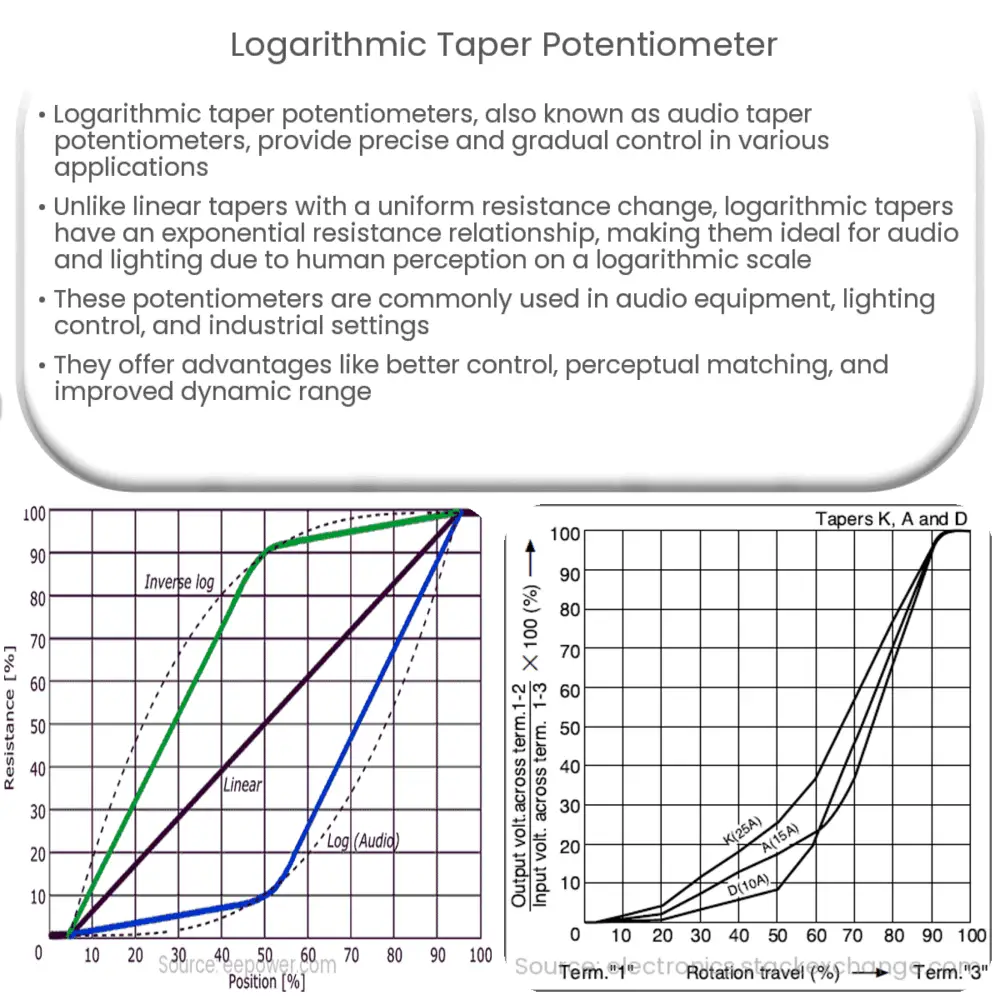A logarithmic taper potentiometer offers precise, gradual control in applications like audio equipment, lighting, and industrial systems.

Logarithmic Taper Potentiometer: An Introduction
Overview
A logarithmic taper potentiometer, also known as an audio taper potentiometer or log pot, is an essential electronic component used in various applications where a precise and gradual control of a variable is required. It differs from a linear taper potentiometer in the way its resistance changes in response to the position of the wiper. In this article, we will discuss the working principle, applications, and advantages of using a logarithmic taper potentiometer.
Working Principle
Logarithmic taper potentiometers work on the same basic principle as linear taper potentiometers, which consist of a resistive element, a wiper, and two fixed terminals. As the wiper slides along the resistive element, the resistance between the wiper and the terminals changes. However, unlike linear taper potentiometers, which exhibit a direct and uniform relationship between the wiper’s position and the resistance, logarithmic taper potentiometers have a non-linear relationship.
In a logarithmic taper potentiometer, the resistance changes exponentially as the wiper moves along the resistive element. This means that at the beginning of the taper, small changes in wiper position result in larger changes in resistance, whereas towards the end of the taper, larger changes in wiper position are needed to create the same change in resistance. This logarithmic relationship is ideal for applications that require a more gradual and precise control of variables, such as audio volume control or signal attenuation.
Applications
Logarithmic taper potentiometers are widely used in various applications, including:
- Audio equipment: One of the most common uses of logarithmic taper potentiometers is in audio equipment, such as amplifiers, mixers, and synthesizers. They are often used for volume control, tone control, and signal attenuation, as the human ear perceives sound on a logarithmic scale, making logarithmic taper potentiometers a more natural choice for these applications.
- Lighting control: Another common application of logarithmic taper potentiometers is in lighting control systems, where they can be used to adjust the brightness of lamps or LEDs. The human eye also perceives brightness on a logarithmic scale, making logarithmic taper potentiometers a suitable choice for this purpose.
- Industrial control: Logarithmic taper potentiometers can also be found in various industrial control applications, where they can provide precise control over variables such as temperature, pressure, or flow rate.
Advantages
Logarithmic taper potentiometers offer several advantages over linear taper potentiometers, including:
- Better control: Due to their non-linear response curve, logarithmic taper potentiometers provide more precise and gradual control over variables, making them ideal for applications that require fine adjustments.
- Perceptual matching: Logarithmic taper potentiometers are more suited for applications involving human perception, such as audio volume and lighting control, as they closely match the logarithmic response of the human ear and eye, providing a more natural and intuitive control experience.
- Improved dynamic range: In audio applications, logarithmic taper potentiometers can offer a wider dynamic range compared to linear taper potentiometers, allowing for smoother and more gradual volume adjustments over a larger range.
Selection Criteria
When selecting a logarithmic taper potentiometer for a specific application, several factors should be taken into consideration:
- Resistance range: Choose a potentiometer with a suitable resistance range for your application. Common resistance values for logarithmic taper potentiometers include 10k, 50k, and 100k ohms, but other values are also available.
- Taper type: Logarithmic taper potentiometers come in various taper types, such as A-taper (audio taper) and B-taper (linear taper with a logarithmic section). Select a taper type that best matches the requirements of your application.
- Physical size: Consider the physical dimensions of the potentiometer, including the size of the resistive element, the shaft length and diameter, and the overall size of the component. Choose a potentiometer that fits within the constraints of your design.
- Mounting style: Logarithmic taper potentiometers are available in various mounting styles, such as panel mount, PCB mount, and surface mount. Select a mounting style that is compatible with your application and assembly requirements.
Conclusion
In conclusion, logarithmic taper potentiometers are essential electronic components that offer precise and gradual control of variables, making them ideal for applications involving human perception, such as audio equipment and lighting control. By understanding the working principle, applications, advantages, and selection criteria of logarithmic taper potentiometers, you can make informed decisions when selecting and implementing these components in your projects.

